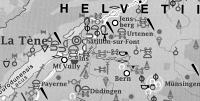Book Review

JOHN T. KOCH in collaboration with RAIMUND KARL, ANTONE MINARD & SIMON Ó FAOLÁIN. An atlas for Celtic studies: archaeology and names in ancient Europe and Early Medieval Ireland, Britain, and Brittany. viii+215 pages, numerous b&w & colour maps. 2007. Oxford: Oxbow; 978-1-84217-309-1 hardback £50.
Review by Olivier Buchsenschutz
Ecole Normale Supérieure - CNRS, Paris, France
(Email: buchs@ens.fr)
(Translated from the French by Reviews Editor)
Here is a work that is surprising on more than one count, starting with its scope, which tries to embrace the entire Celtic world from the prince of Hochdorf to King Arthur and from Scotland to Turkey.
Let us start with the plan, complex to say the least. Thirteen pages of introduction are used to justify the choice of subject, followed by a ten-page commentary on the authors' perceptions of the history of this wide Celtic world. Thereafter the atlas unfolds, in 66 sheets numbered and divided into 25 maps which are themselves subdivided. This, the heart of the work, is followed by a third chapter which describes methodically the sources used: these are arranged in paragraphs whose numbering picks up where the atlas left off (i.e. from 26 to 394) and which are often supplemented by thematic maps. The sources are listed in two parts: the 'ancient horizon' and the early medieval one. Considered in turn in each group are: site types, artefact distributions, linguistic data, and battle sites and boundaries. Paragraph 391 is followed by a 12-page summary list of inscriptions which appear on the early medieval maps. The book is rounded off by a bibliography, which can be described as very disparate, and by an index, most useful for locating the sites on the maps.
Let us now turn to the general maps. Scales vary, seemingly to compensate for distortions in the Mercator projection. Fortunately there is a metric scale printed on each sheet, but it is not possible to assemble them. Hydrography is precise (though the rivers are not named) and the relief well represented and legible. The legends featuring sites and artefacts systematically refer to the paragraphs of chapter 3, which is most useful. Conversely, the authors had to create hundreds of different symbols to render the wealth of information. The maps are thus inventory maps, designed to answer a single question: 'what is where?' This inventory aspect is emphasised by the choice of symbols which refer more or less to the objects featured (sword, chariot, mirror, etc.) but which have no distinguishing graphic value. The colour of the lettering distinguishes between Celtic names, non-Celtic place-names and modern names. Tribal names are in black capitals. Large white initials locate place-names ending in -briga, -dunon and other well known toponyms. The large Celtic-speaking regions are delineated by a white line. Having tested the information on regions I am familiar with, I can report that the most important information is indeed present, as one would expect from a map at a scale of 1:2000000. It goes without saying that the distributions depend on the references consulted. My impression is that syntheses on specific artefact types or categories of sites have been used in priority, without consulting the archaeological inventories generated by the various countries. In sum, this is an inventory map which looks like a tourist map. The thematic distribution maps, mostly taken from well-known publications, figure with the presentation and commentary of the sources.
Turning back to the introduction, let us examine the intentions of the authors. These are explicitly to avoid a 'narrative' history of the Celts; instead the authors aim to present the data in their raw state, and by juxtaposing them on maps hope to shine new light on the subject. It is up to the reader to make links between the very diverse phenomena depicted. This prudence is to the authors' credit. A well-informed reader will immediately be aware of the biases inherent in the sources he is conversant with; but what will a student or an interested non-specialist make of it? The juxtaposition of so much non-comparable data cannot avoid creating the impression of a metro plan or mail-order the catalogue. The authors cast the lacunae in our knowledge in sharp relief: we know too little about such a long period over such a large territory. It could not be otherwise, given that the authors adopted a resolutely analytical approach but based themselves on a relatively summary documentation. Nevertheless, let us salute the work accomplished and the underlying concern to go back to the sources. But the historical atlas of the Celts remains to be written.



